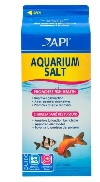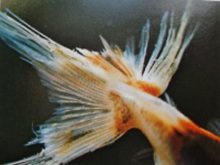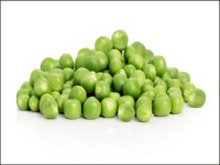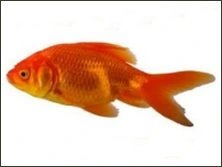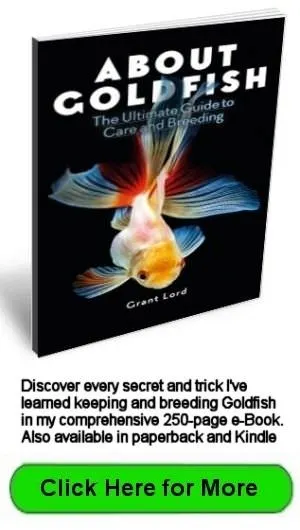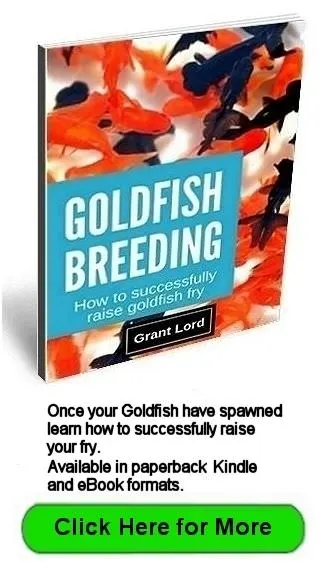- Home
- Disease Causes
- Common Goldfish Diseases
- Anchor Worm Treatments
Goldfish Anchor Worm Treatment
This worm is a free-swimming crustacean that attaches itself to fish and feeds on its blood.
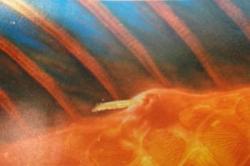 Anchor worm embedded in a Goldfish
Anchor worm embedded in a GoldfishAnchor worm (Lernaea cyprinacea) is a member of the Copepod family, a family of very small aquatic crustaceans.
They get their name from the shape of the female's head which resembles a ship’s anchor.
The female worms burrow their heads into the bodies of Goldfish. The most common places to find them are behind a pectoral fin or right behind the dorsal fin. If the infestation is heavy, they can be found anywhere on the fish.
Anchor Worm Symptoms
When the worm first attacks the fish, it shows as a bony splinter protruding at an angle. It is visible to the naked eye but can easily be missed.
As the fish’s defense system starts to react to the worm’s presence, a bloody red spot will show with a small white-green or red thread protruding from the center.
Other early symptoms of infestation can include:
- Frequent rubbing or flashing
- localized redness
- Breathing difficulties
- General lethargy
Goldfish Anchor Worm Sources
Infested fish introduced into the pond or aquarium is the usual source although newly hatched free-swimming nauplii (juveniles) may be introduced from contaminated water.
Anchor Worm Life Cycle
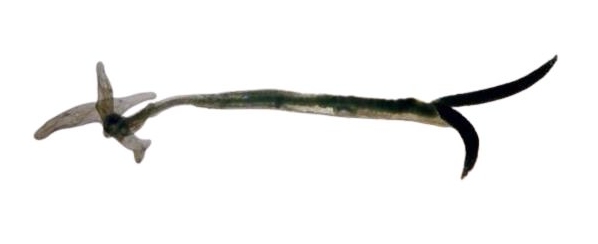 Adult female anchor worm
Adult female anchor wormThis parasite thrives at warmer water temperatures ideally 26oC-28oC (79oF-82oF). At these temperatures, the entire life cycle takes between 18-25 days. At temperatures below 20oC (68oF) juveniles are unable to complete their development, and at 14oC (57oF) and below females will not produce eggs.
Adult females are able to survive winter temperatures on a host until warmer spring temperatures stimulate egg production.
Anchor worms don’t need an intermediate host, they spread directly from infected fish to fish during different life stages, both on and off a host.
After mating, the male dies, and the female bores into the host’s tissue to permanently attach itself. The female finishes maturing into an adult, and within 24 hours begins to release eggs from a pair of sacs located at the exposed end of its body.
The eggs hatch within 24-36 hours. The females are very prolific, producing batches of up to 250 nauplii (juveniles) every two weeks over the 16 weeks of their lifespan.
Newly hatched nauplii are not parasitic and develop through three different stages over about four days. They then molt into the first copepodid or free swimming larval stage and become parasitic, often infesting the gills of the host.
Over the next seven days, the parasite goes through five more copepodid stages, usually still in the gills of the host. Once they have reached the last stage, the parasites mate, with the male detaching from the host and dying within 24 hours. The female either finds another host or burrows into the existing host’s tissue to continue the reproductive cycle.
Treatment Options for Aquariums
A safe and convenient treatment is to use a medication specifically made for parasitic crustaceans such as Ecological Labs LAWP16 Microbe Lift Lice and Anchor Worm treatment.
As its name suggests, it can also be used for the treatment of Goldfish Lice as they are also a parasitic crustacean.
Other treatments include:
- If your goldfish are in an aquarium, picking a few worms off the fish with tweezers may be the easiest solution.
Anchor worms hold on tenaciously and small pieces of flesh can come with the worms. Dab the worms with a cotton bud that has been dipped in a 50/50 solution of Kerosene and Turpentine.
Be very careful if the worm is near an eye. This process may need to be performed more than once.
- 15 – 30 minute bath in a light pink solution of potassium permanganate (1 part to 10,000 solution).
- 10 – 15 minute bath in a 1 part to 4,000 solution of formalin.
Watch closely for toxic shock, usually exhibited by the fish turning on its side or gasping at the surface.
Treatment Options for Ponds
Dipterex (Dylox neguvon) is effective in combating the worm in ponds.
It is an insecticide that is soluble in water, comes in liquid or powder form and is sold in different potencies ranging from 40 to 98%.
Try and find Dipterex with 98% potency as the doses below are based on this potency level. If you can only find lower potency levels, you will have to calculate how much you need based on the doses below.
Dipterex Dosage For Ponds
- 1 part Dipterex to 3-5 million parts water or
- 1 milliliter to 660 – 1100 Imp gallons of water or
- 1 milliliter to 790 – 1320 US gallons of water.
Treat the pond three times at 7 day intervals.
Dipterex isn’t stable in water and breaks down after a few days. The worm eggs survive the treatment but emerging parasites are killed by the follow-up treatments.
Note: You must be very careful calculating the dosage of this chemical.
Precaution
Do not treat when water temperatures are below 18oC (64oF) as fish cannot metabolize/excrete it fast enough.
Do not treat when water temperatures are above 28oC (82oF) as fish uptake rate is too high.
Move the fish into a mild salt bath of two teaspoons per gallon of Aquarium salt for a couple of days to make sure wounds don’t become infected or any more worms appear.
Don't forget to sterilize the aquarium completely (including plants) to kill any adults or nauplii.
Top of Goldfish Anchor Worm Treatment page

